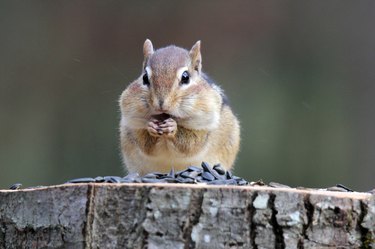While mischievous cartoon chipmunks may seem like a lot of fun, the real ones are sometimes annoying. It's cute to watch them as they scamper through the yard, but chipmunks are still rodents and bring problems. These little critters commonly dig up plant bulbs, leave holes in the lawn and invade attics and other indoor spaces, where they give birth to more chipmunks. They also dig around building foundations and sidewalks, sometimes damaging them. Damage is more likely when chipmunks are present in large numbers. To get rid of them humanely, you'll need to eliminate the things that attract them, add a few that repel them and exclude them from inside buildings. If the critters continue to persist, you can try trapping and relocating them.

Video of the Day
Landscape Lookout
It's often the case that homeowners with chipmunk problems have unknowingly laid out the red carpet for them. Like all living creatures, chipmunks need food, water and shelter. They also need plenty of cover to hide them from predators. If your lawn offers all of these things, you've created your own chipmunk heaven, and you need to dismantle it.
Video of the Day
To tackle the food problem, cover any tasty bulbs in your garden with 1/4-inch hardware cloth or wire mesh. Extend the covering at least 1 foot beyond the borders of your garden, covering it with soil if you dislike its appearance. At planting time, add some broken seashells or roughly crushed gravel into the planting holes to discourage chipmunks from digging. If you maintain a bird feeder, place it at least 15 to 30 feet away from areas where you don't want chipmunks. Do the same with the birdbath, if you have one. Pick up any toys or debris in the lawn so that rainwater doesn't collect in them and provide drinking water.
You'll also need to break up planting beds and landscaping. Ground covers, bushes, wood piles and densely planted flower beds must never form a continuous path around the property. These items provide cover for chipmunks, permitting them to run from one area to the next without ever exposing themselves to predators. Make sure there are some open spaces where chipmunks will feel exposed and uncomfortable. Keep the grass around outbuildings and other structures weed whacked at all times, as well, since tall grass and weeds near these structures provide perfect hiding places for burrow openings.
Rodent Repellents
While repellents that smell like predators generally don't work on chipmunks, taste repellents often do. To keep chipmunks away from bulbs and seeds, coat them in a foul tasting concoction before planting them. Available commercially, these repellents contain bitrex, thiram or ammonia soaps. They are usually labeled as repelling squirrels but work equally well on chipmunks. In addition to dipping bulbs in these chemicals, you can also spray them on plants and seedlings or apply granular versions of them to your planting beds. You will have to reapply them frequently, however, and you can't use them on plants you intend to consume.
Electronic repellents may also provide chipmunk relief. These devices become active because of motion detectors. When a chipmunk or other animal activates them, they spray a jet of water or make a noise that frightens the animal away.
Be Exclusive
Chipmunks breed in early spring and sometimes during the summer or early in the fall. The result is usually a new brood of two to seven chipmunks sometime between April and July. Expectant mothers looking for safe nesting areas often infiltrate attics, sheds and other indoor areas at this time. To prevent this, search your home and outbuildings for holes and cracks that could grant a pregnant chipmunk access and plug them using caulk or 1/4-inch mesh. Make sure you do this either very early or very late in the mating season so you don't accidentally trap baby chipmunks inside your home.
Trap and Relocate
In areas where it's legal to do it, you can control chipmunk populations by trapping the animals and relocating them. To do this, purchase a small live trap designed for squirrels, chipmunks and other small animals. Bait the trap with peanut butter, seeds or peanuts and then place it in areas where chipmunk damage is present or where there's adequate cover for the animals. Wear gloves when handling the trap to avoid leaving your scent behind. When you do snare a chipmunk, release him at least five miles away from your property so he doesn't return. Consider that you may trap a mother chipmunk, leaving her babies defenseless after you relocate her.
When trapping and releasing any animals, you must always secure permission from the landowner before releasing them on a property that's not your own. Always check your traps frequently, so the animals you catch don't starve or die of exposure on hot days. Catching unintended prey, such as squirrels or mice, is a common occurrence and another reason to check your traps frequently. You won't catch chipmunks in traps that are already full. Consider trapping as a last resort since relocating large chipmunk populations is a time-consuming endeavor. The chipmunks may breed faster than you can relocate them, making it impossible to remove all of the individuals in a chipmunk community. It's still possible to decrease their number and thereby the amount of damage they cause, but recognize that trapping may never rid you of the creatures completely.